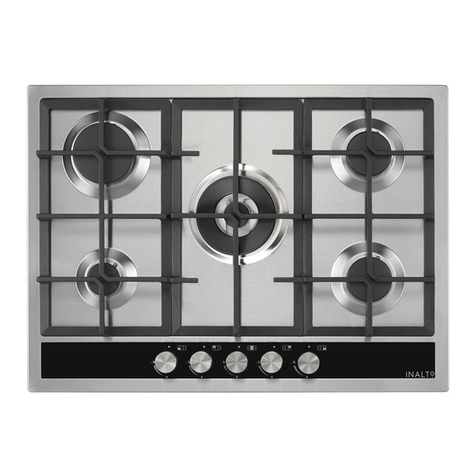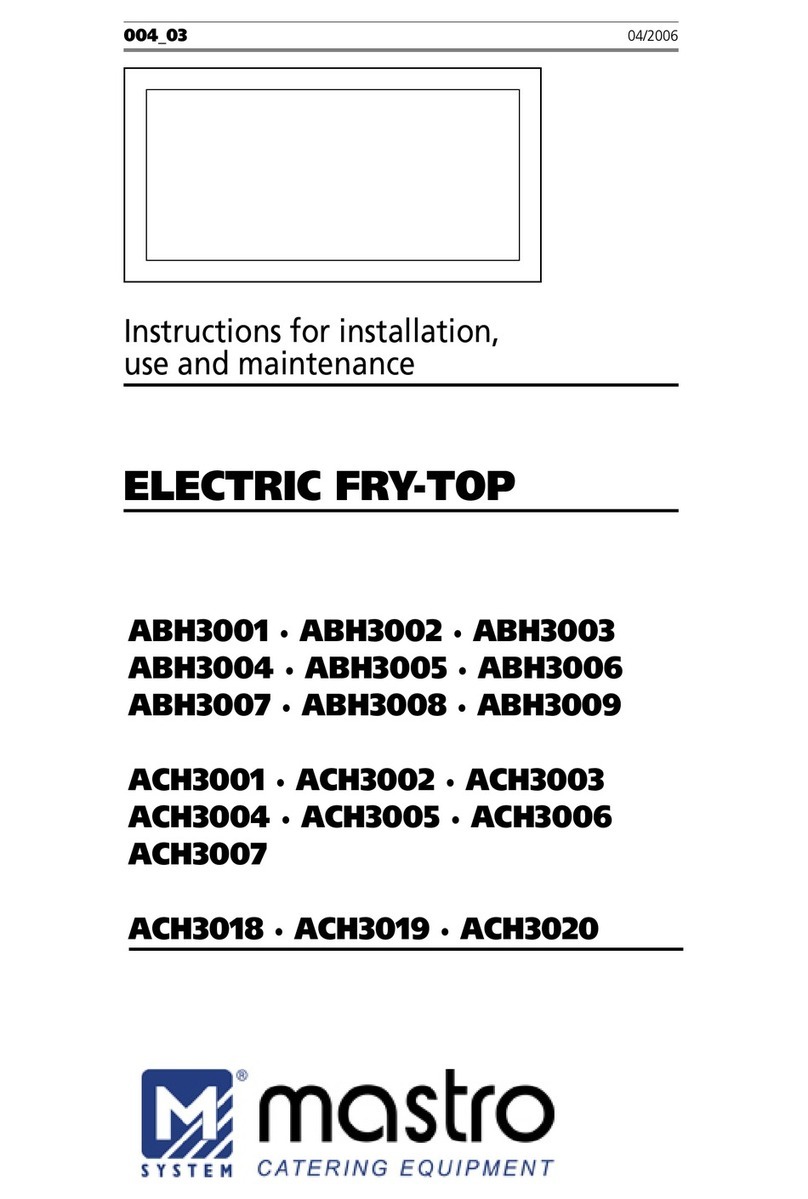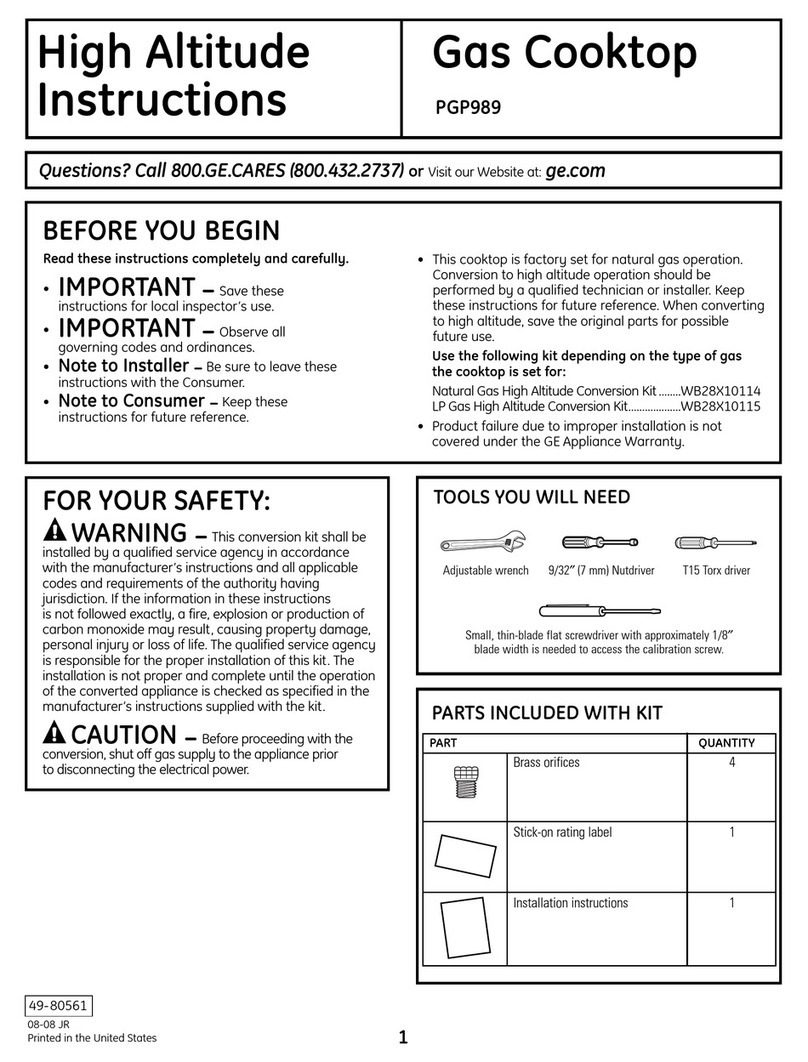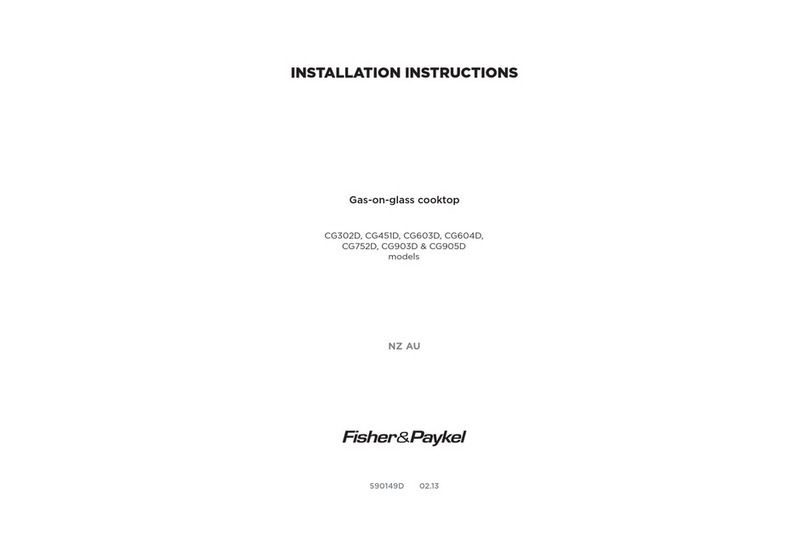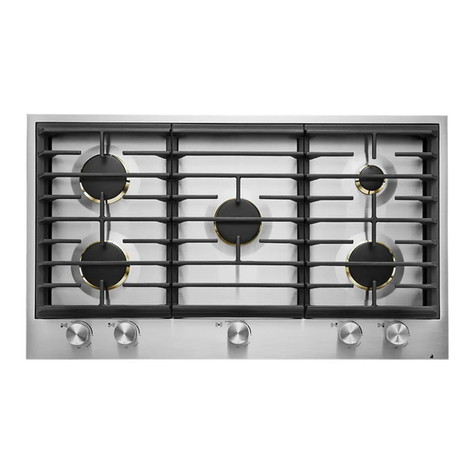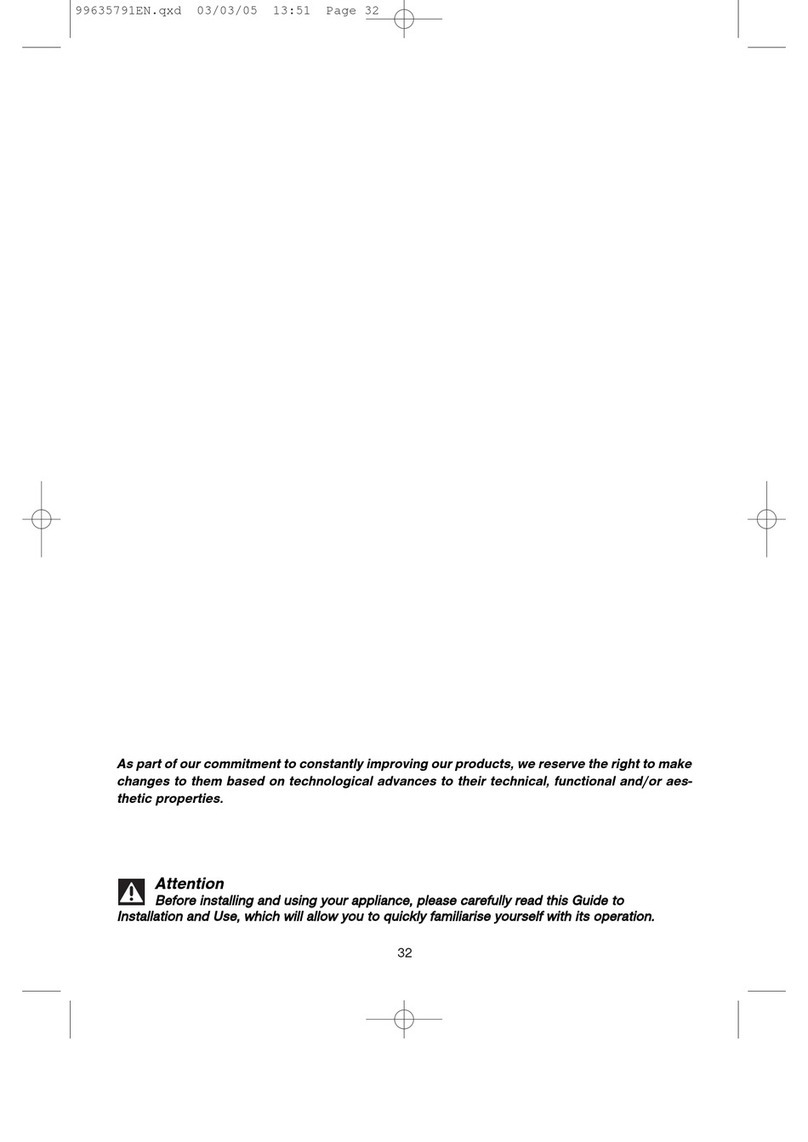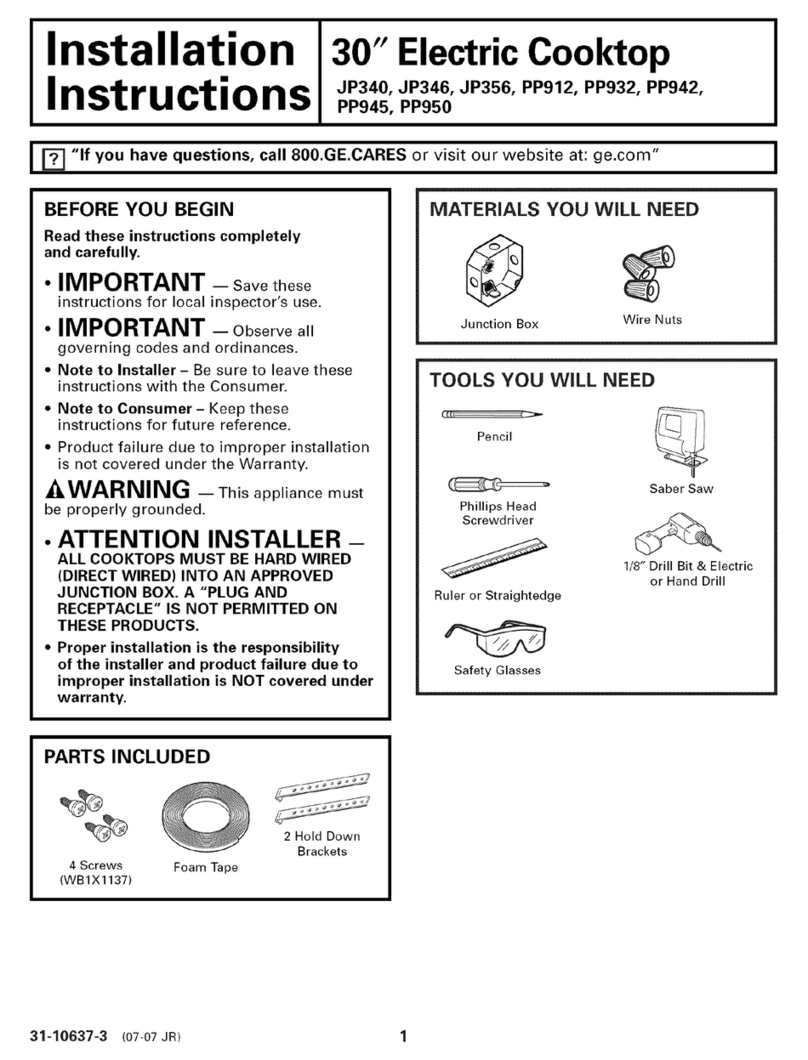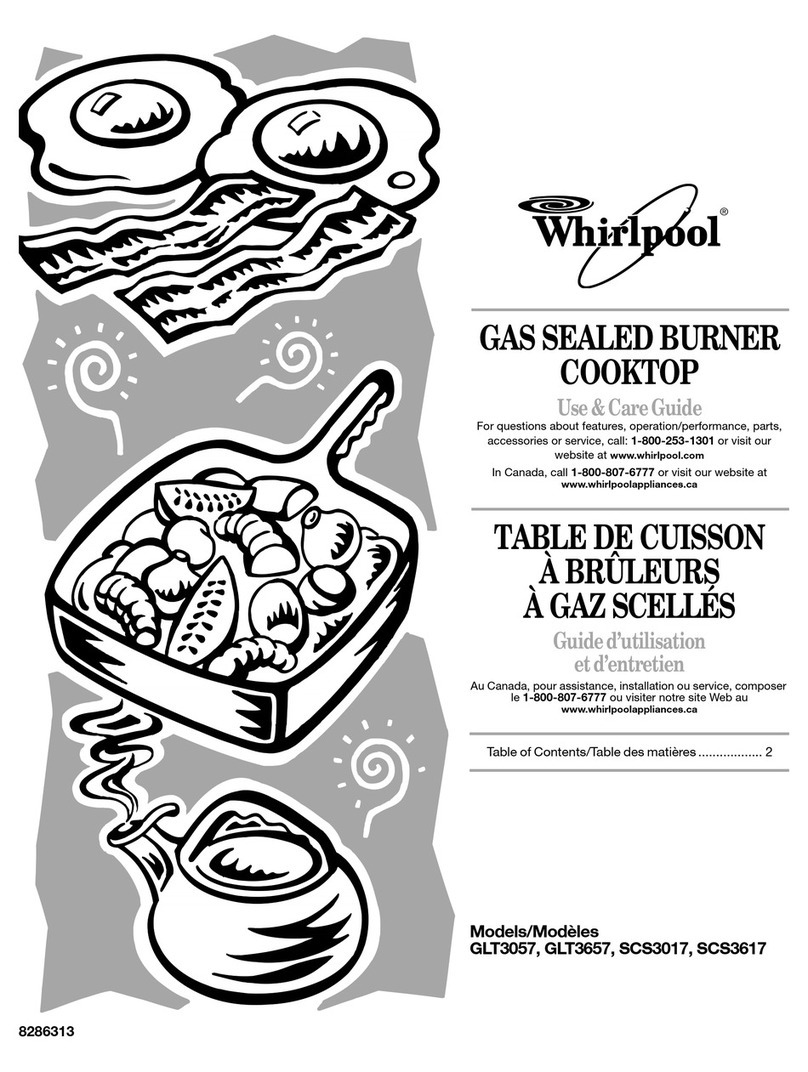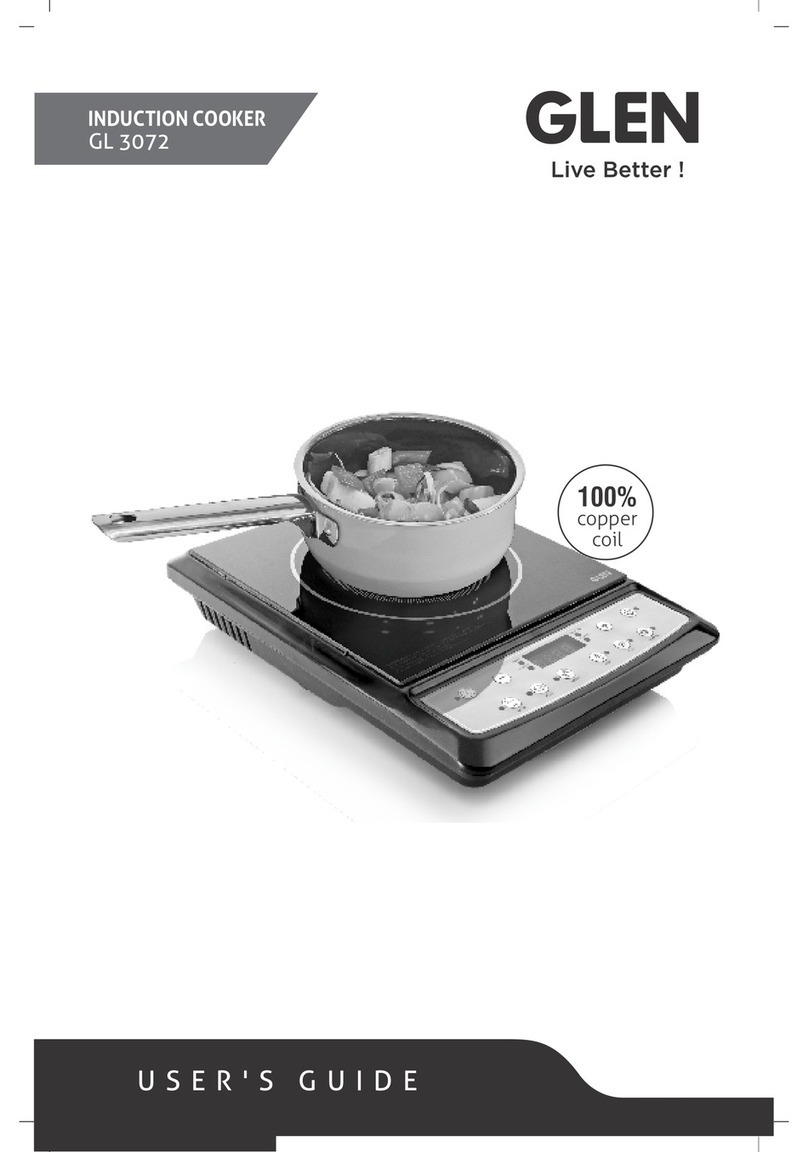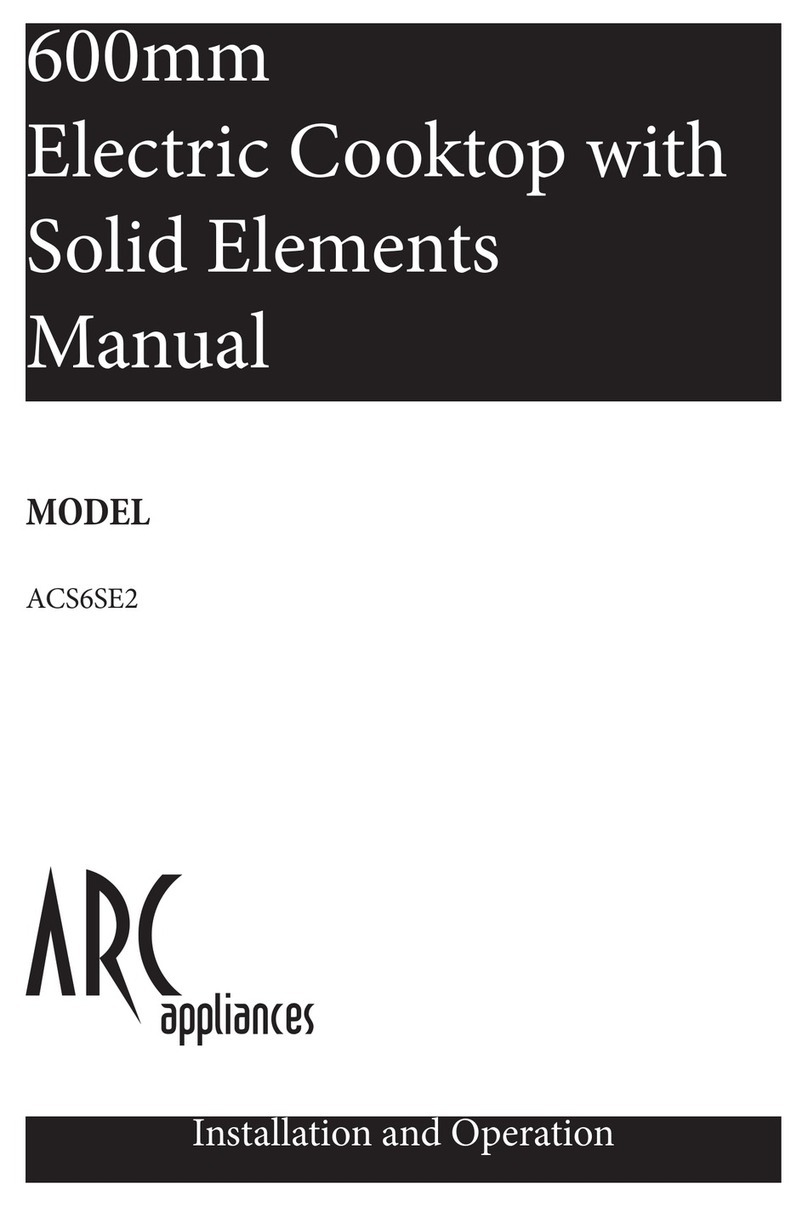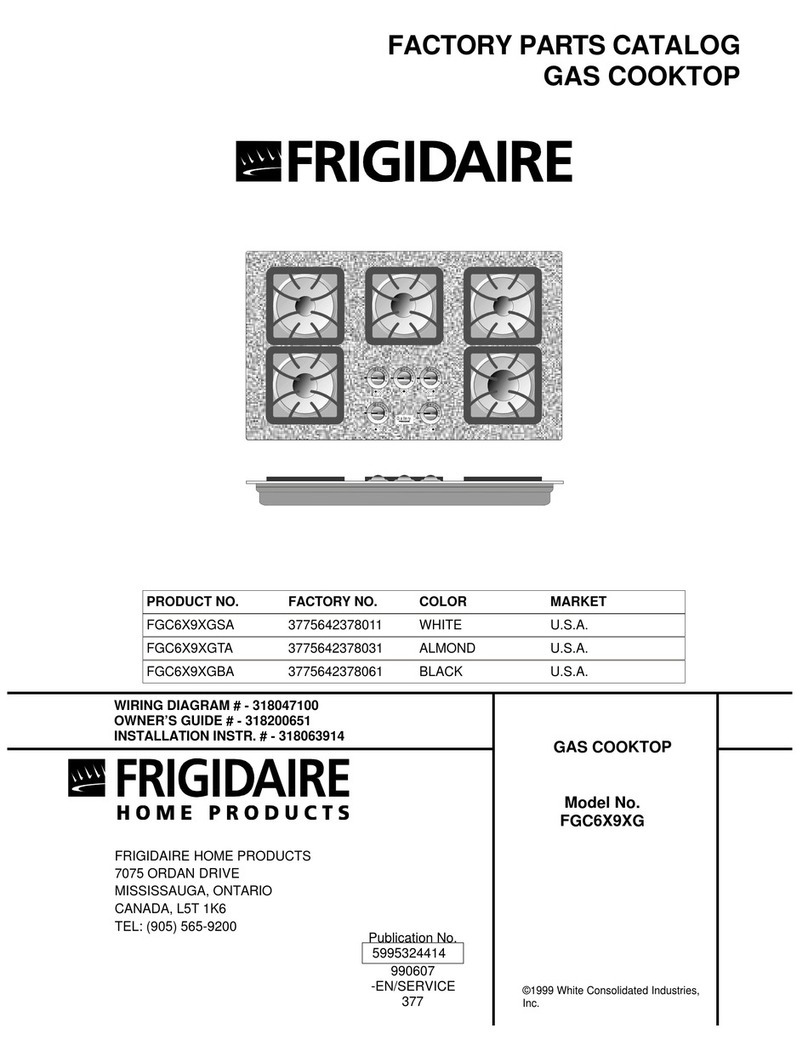Electrolux Professional N7E User manual

Induction cooktops
N7E/N9E
EN Installation and operating manual *
*Original instructions 59589FK02- 2020.04

2
Foreword
The installation, use and maintenance manual (hereinafter Manual) provides the user with information necessary for correct
and safe use of the machine (or “appliance“).
The following must not be considered a long and exacting list of warnings, but rather a set of instructions suitable for improving
machine performance in every respect and, above all, preventing injury to persons and animals and damage to property due to im-
proper operating procedures.
All persons involved in machine transport, installation, commissioning, use and maintenance, repair and disassembly must con-
sult and carefully read this manual before carrying out the various operations, in order to avoid wrong and improper actions that
could compromise the machine's integrity or endanger people. Make sure to periodically inform the user regarding the safety regu-
lations. It is also important to instruct and update personnel authorised to operate on the machine, regarding its use and
maintenance.
The manual must be available to operators and carefully kept in the place where the machine is used, so that it is always at hand
for consultation in case of doubts or whenever required.
If, after reading this manual, there are still doubts regarding machine use, do not hesitate to contact the Manufacturer or the au-
thorised Service Centre to receive prompt and precise assistance for better operation and maximum efficiency of the machine.
During all stages of machine use, always respect the current regulations on safety, work hygiene and environmental protection. It
is the user's responsibility to make sure the machine is started and operated only in optimum conditions of safety for people, ani-
mals and property.
IMPORTANT
• The manufacturer declines any liability for operations carried out on the appliance without respecting the instructions
given in this manual.
• The manufacturer reserves the right to modify the appliances presented in this publication without notice.
• No part of this manual may be reproduced.
• This manual is available in digital format by:
– contacting the dealer or reference customer care;
– downloading the latest and up to date manual on the web site;
• The manual must always be kept in an easily accessed place near the machine. Machine operators and mainte-
nance personnel must be able to easily find and consult it at any time.

3
Contents
A WARNING AND SAFETY INFORMATION...................................................................................................5
A.1 General information ......................................................................................................................5
A.2 Personal protection equipment ........................................................................................................ 6
A.3 General safety .............................................................................................................................6
A.4 Induction general safety.................................................................................................................7
A.5 General safety rules......................................................................................................................7
A.6 Safety signs to be placed near the machine area ................................................................................. 9
A.7 Transport, handling and storage .................................................................................................... 10
A.8 Installation and assembly ............................................................................................................. 10
A.9 Electrical connection ................................................................................................................... 10
A.10 Machine space limits................................................................................................................... 10
A.11 Operating limits.......................................................................................................................... 11
A.12 Positioning................................................................................................................................ 11
A.13 Reasonably foreseeable improper use ............................................................................................ 11
A.14 Machine cleaning and maintenance................................................................................................ 12
A.15 Machine disposal........................................................................................................................ 13
B WARRANTY ....................................................................................................................................... 13
B.1 Warranty terms and exclusions ...................................................................................................... 13
C TECHNICAL DATA............................................................................................................................... 14
C.1 Dataplate position....................................................................................................................... 14
C.2 Appliance and manufacturer's identification data ............................................................................... 14
C.3 Induction appliance..................................................................................................................... 15
D GENERAL INFORMATION .................................................................................................................... 15
D.1 Introduction ............................................................................................................................... 15
D.2 Intended use and restrictions ........................................................................................................ 15
D.3 Testing and inspection ................................................................................................................. 15
D.4 Copyright.................................................................................................................................. 15
D.5 Keeping the manual .................................................................................................................... 15
D.6 Recipients of the manual .............................................................................................................. 15
D.7 Definitions................................................................................................................................. 16
D.8 Responsibility ............................................................................................................................ 16
E NORMAL USE .................................................................................................................................... 16
E.1 Characteristics of personnel trained for normal machine use ................................................................ 16
E.2 Characteristics of personnel enabled to operate on the machine ........................................................... 16
E.3 Operator qualified for normal machine use ....................................................................................... 16
F INSTALLATION AND ASSEMBLY ........................................................................................................... 17
F.1 Introduction ............................................................................................................................... 17
F.2 Customer's responsibilities ........................................................................................................... 17
F.3 Disposal of packing..................................................................................................................... 17
F.4 Joining Appliances...................................................................................................................... 17
F.4.1 Floor fixing....................................................................................................................... 17
F.4.2 Sealing Gaps Between Appliances ....................................................................................... 17
F.5 Installation limits......................................................................................................................... 18
F.6 Gas, electricity, water and other connections (if present, depending on the appliance and/or model) ............. 18
F.7 Electrical connection ................................................................................................................... 18
F.7.1 Electrical appliances .......................................................................................................... 18
F.7.2 To access the terminal board ............................................................................................... 18
F.7.3 Power cable..................................................................................................................... 18
F.7.4 Circuit breaker.................................................................................................................. 18
F.7.5 Equipotential node and Earth connection ............................................................................... 18
G INSTRUCTION FOR THE USER............................................................................................................. 19
G.1 Induction models ........................................................................................................................ 19
G.1.1 Choice of pots .................................................................................................................. 19
G.1.2 Switching on .................................................................................................................... 19
G.1.3 Cooking advice................................................................................................................. 19
G.1.4 Switching off .................................................................................................................... 20
H MACHINE CLEANING AND MAINTENANCE............................................................................................. 20
H.1 Ordinary maintenance ................................................................................................................. 20
H.1.1 Care information ............................................................................................................... 20
H.1.2 Cleaning the appliance and accessories ................................................................................ 20
H.1.3 External parts................................................................................................................... 20
H.1.4 Ceramic — glass surfaces .................................................................................................. 20
H.1.5 Induction surfaces............................................................................................................. 20
H.1.6 Induction air filters ............................................................................................................. 21
H.1.7 Periods of non-use ............................................................................................................ 21
H.1.8 Internal parts (every 6 months)............................................................................................. 21
H.2 Warnings .................................................................................................................................. 21
H.3 Warnings codes ......................................................................................................................... 21
H.4 Inefficiencies detected during cooking ............................................................................................. 22
H.5 Repair and extraordinary maintenance ............................................................................................ 22
H.6 Maintenance intervals.................................................................................................................. 22

4
I MACHINE DISPOSAL........................................................................................................................... 23
I.1 Waste storage............................................................................................................................ 23
I.2 Procedure regarding appliance dismantling macro operations .............................................................. 23
J ENCLOSED DOCUMENTS.................................................................................................................... 24

5
A WARNING AND SAFETY INFORMATION
A.1 General information
To ensure safe use of the machine and a proper understanding of the manual it is
necessary to be familiar with the terms and typographical conventions used in the
documentation. The following symbols are used in the manual to indicate and identify the
various types of hazards:
WARNING
Danger for the health and safety of operators.
WARNING
Danger of electrocution - dangerous voltage.
CAUTION
Risk of damage to the machine or the product.
WARNING
Danger of magnetic fields.
IMPORTANT
Important instructions or information on the product
Read the instructions before using the appliance
Clarifications and explanations
• Only specialised personnel are authorised to operate on the machine.
• This appliance must not be used by minors and adults with limited physical, sensory or
mental abilities or without adequate experience and knowledge regarding its use.
– Keep all packaging and detergents away from children.
– Cleaning and user maintenance shall not be made by children without supervision.
• Do not store explosive substances, such as pressurized containers with flammable
propellant, in this appliance or close to the appliance
• Do not remove, tamper with or make the machine “CE“ marking illegible.
• Refer to the data given on the machine’s data plate “CE“ marking for relations with the
Manufacturer (e.g. when ordering spare parts, etc.).
• When scrapping the machine, the “CE“ marking must be destroyed.

6
A.2 Personal protection equipment
Summary table of the Personal Protection Equipment (PPE) to be used during the various stages of the machine's
service life.
Stage Protective
garments
Safety
footwear
Gloves Glasses Safety
helmet
Transport —● ○ —○
Handling —● ○ — —
Unpacking —● ○ — —
Installation —● ●1— —
Normal use ● ● ●2— —
Adjustments ○ ● — — —
Routine
cleaning
○ ● ●1ˉ3○—
Extraordi-
nary
cleaning
○ ● ●1ˉ3○—
Maintenance ○ ● ○ — —
Dismantling ○ ● ○ ○ —
Scrapping ○ ● ○ ○ —
Key:
●PPE REQUIRED
○PPE AVAILABLE OR TO BE USED IF NECESSARY
—PPE NOT REQUIRED
1. During these operations, gloves must be cut-resistant. Failure to use the personal protection equipment by
operators, specialized personnel or users can involve exposure to damage to health (depending on the
model).
2. During these operations, gloves must be heatproof to protect hands from contact with hot food or hot parts of
the appliance and/or when removing hot items from it. Failure to use the personal protection equipment by
operators, specialised personnel or users can involve exposure to chemical risk and cause possible damage
to health (depending on the model).
3. During these operations, gloves must be suitable for contact with chemical substances used (refer to the
safety data sheet of the substances used for information regarding the required PPE). Failure to use the
personal protection equipment by operators, specialized personnel or users can involve exposure to
chemical risk and cause possible damage to health (depending on the model).
A.3 General safety
• The machines are provided with electric and/or mechanical safety devices for protecting
workers and the machine itself.
• Never operate the machine, removing, modifying or tampering with the guards,
protection or safety devices.
• Do not make any modifications to the parts supplied with the appliance.
• Several illustrations in the manual show the machine, or parts of it, without guards or
with guards removed. This is purely for explanatory purposes. Do not use the machine
without the guards or with the protection devices deactivated.
• Do not remove, tamper with or make illegible the safety, danger and instruction signs
and labels on the machine.
• Place emergency telephone numbers in a visible position.

7
• The A-weighted emission sound pressure level does not exceed 70 dB(A).
• Turn the appliance off in case of fault or poor operation.
• Do not use products (even if diluted) containing chlorine (sodium hypochlorite,
hydrochloric or muriatic acid, etc.) to clean the appliance or the floor under it.
• Do not use metal tools to clean steel parts (wire brushes or Scotch Brite type scouring
pads).
• Do not allow oil or grease to come into contact with plastic parts. Do not allow dirt, fat,
food or other residuals to form deposits on the appliance.
• Do not spray water or use water jets or steam cleaner.
• Do not store or use gasoline or other flammable vapours, liquids or items in the vicinity of
this or any other appliance.
• Do not spray aerosols in the vicinity of this appliance while it is in operation.
A.4 Induction general safety
• The hotplate cannot be cooled with direct jets of water, intentional or accidental (e. g.
when filling pots with water from a side pourer or spill onto the hot-plate).
• The glass-ceramic top (6mm thickness) could be damaged due to punctiform impacts (e.
g. falling of metal object on the surface) or hard handling of the pots.
• If the surface is damaged or cracked, immediately disconnect the appliance or
appropriate part of the appliance from the supply.
• During every normal cooking process the glass-ceramic top is very hot and therefore
must not be touched (burns danger).
• During every normal cooking process must not be left empty pans onto the glass-
ceramic top (overheating danger).
• During every normal cooking process do not place paper, cardboard, cloths, etc.,
between the pot and the glass-ceramic top (risk of fire).
• During every normal cooking process no other object (e.g. plastic vessels, closed tinned
foods, aluminium foil, cutlery or other metal objects) except pots, must be placed on the
hotplate (burns danger). The hotplate must not be used as a rest surface.
• If a splashguard device is used for cooking, it must not have a metal surface.
• During every normal cooking process, objects such as rings, watches, etc., worn by the
user can become very hot if brought near the surface of the appliance (burns danger).
•Anyone fitted with a pacemaker or other metal implants can suffer life-threatening
injuries when using induction appliances. Ask the manufacturer of your implant or
consult your doctor about possible risks before using the cooker.
• Every kind of objects that react to magnetisation (e. g. credit cards, telephone cards,
etc.) must not be placed near or above the glass-ceramic top.
• The induction appliance has internal air cooling. The air intake and outlet openings
located under the appliance must not be blocked with objects or cloths (overheating
danger).
• At the end of cooking always switch off the cooking zones by positioning the relatives
control knobs in the off position.
• It is advisable to use pots specially designed for this induction appliance (refer to G.1.1
Choice of pots), otherwise the appliance may malfunction or become damaged.
A.5 General safety rules
Protection devices installed on the machine
• The guards on the machine are:
fixed guards (e.g. casings, covers, side panels, etc.), fixed to the machine and/or frame
with screws or quick-release connectors that can only be removed or opened with tools.

8
Therefore the user must not remove or tamper with such devices. The Manufacturer
declines any liability for damage due to tampering or their non-use.
Instructions for use and maintenance
• Risks mainly of a mechanical, thermal and electrical nature exist in the machine. Where
possible the risks have been neutralised:
– directly, by means of adequate design solutions.
– indirectly by using guards, protection and safety devices.
• During maintenance, always carried out by personnel qualified, several risks remain, as
these could not be eliminated, and must be neutralised by adopting specific measures
and precautions.
• Do not carry out any checking, cleaning, repair or maintenance operations on moving
parts. Workers must be informed of this prohibition by means of clearly visible signs.
• To guarantee machine efficiency and correct operation, periodical maintenance must be
carried out according to the instructions given in this manual.
• Make sure to periodically check correct operation of all the safety devices and the
insulation of electrical cables, which must be replaced if damaged.
• Repair and extraordinary Maintenance have to be carried out by specialised authorised
personnel provided with all the appropriate personal protection equipment, tools,
utensils and ancillary means.
• Never operate the machine, removing, modifying or tampering with the guards,
protection or safety devices.
• Before carrying out any operation on the machine, always consult the manual which
gives the correct procedures and contains important information on safety.
Residual risks
• The machine has several risks that were not completely eliminated from a design
standpoint or with the installation of adequate protection devices. Nevertheless, through
this manual the Manufacturer has taken steps to inform operators of such risks, carefully
indicating the personal protection equipment to be used by them. In order to reduce the
risks, provide for sufficient spaces while installing the unit.
To preserve these conditions, the areas around the machine must always be:
– kept free of obstacles (e.g. ladders, tools, containers, boxes, etc.);
– clean and dry;
– well lit.
For the Customer's complete information, the residual risks remaining on the machine
are indicated below: such situations are deemed improper and therefore strictly
forbidden.
Residual risk Description of hazardous situation
Slipping or falling The operator can slip due to water or dirt on the
floor
Burns/abrasions (e.g. heating
elements)
The operator deliberately or unintentionally
touches some components inside the machine
without using protective gloves
Electrocution Contact with live parts during maintenance
operations carried out with the electrical panel
powered

9
Residual risk Description of hazardous situation
Sudden closing of the lid/door/
oven door (if present, depending
on the appliance type)
The operator for normal machine use could
suddenly and deliberately close the lid/door/oven
door (if present, depending on the appliance type)
Tipping of loads When handling the machine or the packing
containing it, using unsuitable lifting systems or
accessories or with the unbalanced load
Mechanical safety characteristics, hazards
• The appliance does not have sharp edges or protruding parts. The guards for the
moving and live parts are fixed to the cabinet with screws, to prevent accidental access.
CAUTION
In case of a significant anomaly (e.g. short circuits, wires coming out of the
terminal block, motor breakdowns, worn electrical cable sheathing, smell of
gas indicating possible leakage, etc.) the operator must:
immediately deactivate the machine and disconnect all the supplies
(electricity, gas, water).
A.6 Safety signs to be placed near the machine area
Prohibition Meaning
Do not remove the safety devices
Do not use water to extinguish fires (placed on electrical
parts)
Keep the area around the appliance clear and free from
combustible materials. Do not keep flammable materials in
the vicinity of the appliance
Install the appliance in a well-ventilated place to avoid the
creation of dangerous mixtures of unburnt gases in the
same room
Danger Meaning
caution, hot surface
danger of electrocution (shown on electrical parts with
indication of voltage)
risk of electromagnetic fields
Access forbidden to wearers of electrical stimulator
(pacemakers)

10
End of use
• When the appliance is no longer to be used, make it unusable by removing the mains
power supply wiring.
A.7 Transport, handling and storage
• Due to their size, the machines can be stacked on top of each other during transport,
handling and storage by complying with that specified on the slip placed on the packing.
• Do not stand under suspended loads during loading/unloading operations.
Unauthorised personnel must not enter the work area.
• The weight of the appliance alone is not sufficient to keep it steady.
• For machine lifting and anchoring, do not use movable or weak parts such as: casing,
electrical raceways, pneumatic parts, etc.
• Do not push or pull the appliance to move it, as it may tip over.
• Machine transport, handling and storage personnel must be adequately instructed and
trained regarding the use of lifting systems and personal protection equipment suitable
for the type of operation carried out (e.g. overalls, safety shoes, gloves and helmet).
• When removing the anchoring systems, make sure the stability of the machine parts
does not depend on the anchoring and, therefore, that this operation does not cause the
load to fall off the vehicle. Before unloading the machine components, make sure all the
anchoring systems are removed.
• Machine positioning, installation and disassembly must be carried out by specialised
personnel.
A.8 Installation and assembly
• The operations described must be carried out by personnel qualified (refer to E.1
Characteristics of personnel trained for normal machine use) in compliance with the
current safety regulations, regarding the equipment used and the operating procedures.
• The plug, if present, must be accessible after positioning the appliance in the place of
installation.
• Disconnect the appliance from the power supply before carrying out any installation
procedure.
A.9 Electrical connection
Before connecting, make sure the mains voltage and frequency match those indicated on
the appliance data plate.
• Work on the electrical systems must only be carried out by specialised personnel.
• Connection to the power supply must be carried out in compliance with the regulations
and provisions in force in the country of use; arrange a suitable high-sensitivity manual-
reset differential omnipolar thermal-magnetic switch with contact gap enabling complete
disconnection in category III overvoltage conditions.
• If the power cable is damaged, it must be replaced by the Customer Care Service or in
any case by specialised personnel, in order to prevent any risk.
• Verify that a safety circuit breaker is installed between the power cable of the appliance
and the mains electric line. The contact opening max. distance and leakage current
must comply with the local safety regulations.
• Be sure to power the equipment with systems that are protected against overvoltage;
the manufacturer declines all responsibility for effects due to anomalies induced by the
electrical supply system.
A.10 Machine space limits
• A suitable space must be left around the appliance (for operations, maintenance, etc.).

11
• This space must be increased in case of use and/or transfer of other equipment and/or
means or if exit routes are necessary inside the workplace.
A.11 Operating limits
Induction appliances: to guarantee continuous operation at maximum power, the room
temperature must be below 40℃.
A.12 Positioning
• Install the appliance, taking all the safety precautions required for this type of operation,
also respecting the relevant fire-prevention measures.
• Handle the appliance with care in order to avoid damage or danger to people. Use a
pallet for handling and positioning.
• The installation diagram gives the appliance overall dimensions and the position of
connections (gas, electricity, water). Check that they are available and ready for making
all the necessary connections.
• Prevent the areas where the machine is installed to be polluted with corrosive
substances (chlorine, etc.). In case such prevention cannot be guaranteed, the entire
stainless steel surface has to be coated by a paraffin protective film spread by using a
rag soaked with paraffin. The manufacturer declines any liability for corrosive effects
due to external causes.
• The appliance can be installed separately or combined only with other appliances of the
same range.
• The appliances are not suitable for recess-mounting. Leave a space of at least 250 mm
between the appliance and side walls and 100 mm from the rear wall, or in any case an
adequate space to enable subsequent servicing or maintenance operations.
• Suitably insulate surfaces that are at distances less than that indicated.
• Maintain a distance of at least 250 mm between the appliance and any combustible
walls. Do not store or use flammable materials and liquids near the appliance.
• Check and, if necessary, level the appliance after positioning. Incorrect levelling can
cause appliance malfunctioning.
• Wear protective gloves and unpack the machine, carrying out the following operations:
– cut the straps and remove the protective film, taking care not to scratch the surface if
scissors or blades are used;
– remove the cardboard top, the polystyrene corners and the vertical protection pieces;
– for appliances with stainless steel cabinet, remove the protective film very slowly
without tearing it, to avoid leaving glue stuck to the surface;
– should this happen, remove the traces of glue with a non-corrosive solvent, rinsing it
off and drying thoroughly;
– go over all stainless steel surfaces vigorously with a cloth moistened with paraffin oil
in order to create a protective film.
• In case of electrical permanent connection: the device must be lockable in the open
position and accessible even after the appliance is installed in its place.
WARNING
Keep the ventilation openings in the appliance casing free of any obstructions.
A.13 Reasonably foreseeable improper use
Improper use is any use different from that specified in this manual. During machine
operation, other types of work or activities deemed improper and that in general can involve

12
risks for the safety of operators and damage to the appliance are not allowed. Reasonably
foreseeable improper use includes:
• lack of machine maintenance, cleaning and periodical checks;
• structural changes or modifications to the operating logic;
• tampering with the guards or safety devices;
• failure to use personal protection equipment by operators, specialised personnel and
maintenance personnel;
• failure to use suitable accessories (e.g. use of unsuitable equipment or ladders);
• keeping combustible or flammable materials, or in any case materials not compatible
with or pertinent to the work, near the machine;
• wrong machine installation;
• placing in the machine any objects or things not compatible with its use, or that can
damage the machine, cause injury or pollute the environment;
• climbing on the machine;
• non-compliance with the requirements for correct machine use;
• other actions that give rise to risks not eliminable by the Manufacturer.
The previously described actions are prohibited!
A.14 Machine cleaning and maintenance
• Before carrying out any cleaning or maintenance, disconnect the appliance from the
power supply and carefully unplug it and empty all the water / oil tanks or grease
collecting container (if presents).
• During maintenance, the cable and plug must be kept in a visible position by the
operator carrying out the work.
• Do not touch the appliance with wet hands or feet or when barefoot.
• Do not remove the safety guards.
• Use a ladder with suitable protection for work on appliances with high accessibility
(depending on the appliance type).
• Use suitable personal protection equipment (protective gloves). Refer to “A.2 Personal
protection equipment“ for suitable personal protection equipment.
Ordinary maintenance
• Disconnect the power supply before cleaning the appliance.
• Do not clean the machine with jets of water.
Precaution in case of long periods
• Machine maintenance, checking and overhaul operations must only be carried out by
specialised personnel or the Customer Care Service, provided with adequate personal
protection equipment (safety shoes and gloves), tools and ancillary means.
• Work on the electrical equipment must only be carried out by a specialised electrician or
the Customer Care Service
• Put the machine in safe conditions before starting any maintenance operation.
• Respect the requirements for the various routine and extraordinary maintenance
operations. Non-compliance with the instructions can create risks for personnel.
Preventive maintenance
• In order to ensure the safety and performance of your equipment, it is recommended
that service is undertaken by Electrolux authorised engineers every 12 months, in
accordance with Electrolux Service Manuals. Please contact your local Electrolux
Service Centre for further details.

13
Repair and extraordinary maintenance
• Repair and extraordinary Maintenance have to be carried out by specialised authorised
personnel. The manufacturer declines any liability for any failure or damage caused by
the intervention of an unauthorised technician by the Manufacturer and the original
manufacturer warranty will be invalidated.
Parts and accessories
• Use only original accessories and/or spare parts. Failure to use original accessories
and/or spare parts will invalidate the original manufacturer warranty and may render the
machine not compliant with the safety standard.
A.15 Machine disposal
• Dismantling operations must be carried out by specialised personnel.
• Work on the electrical equipment must only be carried out by specialised personnel, with
the power supply disconnected.
• Make the appliance unusable by removing the power cable and any compartment
closing devices, to prevent the possibility of someone becoming trapped inside.
B WARRANTY
B.1 Warranty terms and exclusions
If the purchase of this product includes warranty coverage,
warranty is provided in line with local regulations and subject to
the product being installed and used for the purposes as
designed, and as described within the appropriate equipment
documentation.
Warranty will be applicable where the customer has used only
genuine spare parts and has performed maintenance in
accordance with Electrolux Professional user and mainte-
nance documentation made available in paper or electronic
format.
Electrolux Professional strongly recommends using Electrolux
Professional approved cleaning, rinse and descaling agents to
obtain optimal results and maintain product efficiency over
time.
The Electrolux Professional warranty does not cover:
• service trips cost to deliver and pick up the product;
• installation;
• training on how to use/operate;
• replacement (and/or supply) of wear and tear parts unless
resulting from defects in materials or workmanship reported
within one (1) week from the failure;
• correction of external wiring;
• correction of unauthorized repairs as well as any damages,
failures and inefficiencies caused by and/or resulting from;
– insufficient and/or abnormal capacity of the electrical
systems (current/voltage/frequency, including spikes
and/or outages);
– inadequate or interrupted water supply, steam, air, gas
(including impurities and/or other that does not comply
with the technical requirements for each machine);
– plumbing parts, components or consumable cleaning
products that are not approved by the manufacturer;
– customer’s negligence, misuse, abuse and/or non-com-
pliance with the use and care instructions detailed within
the appropriate equipment documentation;
– improper or poor: installation, repair, maintenance
(including tampering, modifications and repairs carried
out by third parties not authorized) and modification of
safety systems;
– Use of non-original components (e. g.: consumables,
wear and tear, or spare parts);
– environment conditions provoking thermal (e. g. over-
heating/freezing) or chemical (e. g. corrosion/oxidation)
stress;
– foreign objects placed in- or connected to- the product;
– accidents or force majeure;
– transportation and handling, including scratches, dents,
chips, and/or other damage to the finish of the product,
unless such damage results from defects in materials or
workmanship and is reported within one (1) week of
delivery unless otherwise agreed;
• product with original serial numbers that have been
removed, altered or cannot be readily determined;
• replacement of light bulbs, filters or any consumable parts;
• any accessories and software not approved or specified by
Electrolux Professional.
Warranty does not include scheduled maintenance activities
(including the parts required for it) or the supply of cleaning
agents unless specifically covered within any local agreement,
subject to local terms and conditions.
Check on Electrolux Professional website the list of authorized
customer care.

14
C TECHNICAL DATA
C.1 Dataplate position
IMPORTANT
This instruction manual contains information relevant to various appliances. See the dataplate located under the control
panel to identify the appliance (see fig. below).
IMPORTANT
When installing the appliance, make sure the electrical connection is carried out in compliance with that specified on the
data plate.
C.2 Appliance and manufacturer's identification data
The dataplate gives the product identification and technical data. The meaning of the various information given on it is listed below:
F.Mod. factory description of product
Comm.Model commercial description
PNC production number code
Ser.No. serial number
Type family type
El power supply voltage + phase
Hz power supply frequency
kW max. power input
A current absorbed
Power unit El. power
I dust and water protection rating
CE CE marking
N certification group
L dust and water protection rating
Electrolux Professional SpA Viale Treviso 15 33170 Porde-
none Italy
manufacturer
Type

15
C.3 Induction appliance
Models
N7E
N7CIN IH720 IH740 IH72P IH74P
+7INEDW00P +7INED2000 +7INEH4000 +7INEH2F0P +7INED200P +7INEH400P
400mm 400mm 800mm 800mm 400mm 800mm
Power
supply
voltage
V380–415 380–415 380–415 380–415 380–415 380–415
Frequency Hz. 50/60 50/60 50/60 50/60 50/60 50/60
Phases Nr. 3 3 3 3 3 3
Hotplates Nr. 1 2 4 2 2 4
Max total
power kW 5 7 14 10 10 20
Power
supply cable
section
mm2 2,5 2,5 42,5 2,5 6
Models
N9E
N9CIN IH920 IH940
+9INEDW00P
+9HHCDAOMCE
+9INED2008
+9HHADAOMCE
+9INEH4008
+9HHBDAOMEE
400mm 400mm 800mm
Power supply voltage V380–415 380–415 380–415
Frequency Hz. 50/60 50/60 50/60
Phases Nr. 3 3 3
Hotplates Nr. 1 2 4
Max total power kW 5 10 20
Power supply cable
section mm2 2,5 2,5 6
D GENERAL INFORMATION
WARNING
Refer to “WARNING and Safety
Information“
D.1 Introduction
Given below is some information regarding the intended use of
this appliance, its testing, and a description of the symbols
used (that identifies the type of warning), the definitions of
terms used in the manual and useful information for the
appliance user.
D.2 Intended use and restrictions
This appliance is designed for cooking food. It is intended for
commercial use.
This appliance must not be used by minors and/or adults
with limited physical, sensory or mental abilities or with-
out adequate experience and knowledge regarding its use.
Children shall not play with the appliance. Cleaning and user
maintenance shall not be made by children without supervision.
CAUTION
The machine is not suitable for installation
outdoors and/or in places exposed to
atmospheric agents (rain, direct sunlight,
etc.).
D.3 Testing and inspection
Our appliances have been designed and optimized, with
laboratory testing, in order to obtain high performance and
efficiency.
Passing of the tests (visual inspection - gas/electrical test -
functional test) is guaranteed and certified by the specific
enclosures.
D.4 Copyright
This manual is intended solely for consultation by the operator
and can only be given to third parties with the permission of
Electrolux Professional SpA.
D.5 Keeping the manual
The manual must be carefully kept for the entire life of the
machine, until scrapping. The manual must stay with the
machine in case of transfer, sale, hire, granting of use or
leasing.
D.6 Recipients of the manual
This manual is intended for:
• the carrier and handling personnel;
• installation and commissioning personnel;
• the employer of machine users and the workplace
manager;
• operators for normal machine use;
• specialised personnel - Customer Care service (see service
manual).

16
D.7 Definitions
Listed below are the definitions of the main terms used in the
manual. It is advisable to read them carefully before use.
Operator machine installation, adjustment, use,
maintenance, cleaning, repair and trans-
port personnel.
Manufacturer Electrolux Professional SpA or any other
service centre authorised by Electrolux
Professional SpA.
Operator for
normal
machine use
an operator who has been informed and
trained regarding the tasks and hazards
involved in normal machine use.
Customer
Care service
or specialised
personnel
an operator instructed/trained by the
Manufacturer and who, based on his
professional and specific training, experi-
ence and knowledge of the accident-
prevention regulations, is able to appraise
the operations to be carried out on the
machine and recognise and prevent any
risks. His professionalism covers the
mechanical, electrotechnical and elec-
tronics fields etc.
Danger source of possible injury or harm to health.
Hazardous
situation
any situation where an operator is
exposed to one or more hazards.
Risk a combination of probabilities and risks of
injury or harm to health in a hazardous
situation.
Protection
devices
safety measures consisting of the use of
specific technical means (guards and
safety devices) for protecting operators
against risks.
Guard an element of a machine used in a specific
way to provide protection by means of a
physical barrier.
Safety device a device (other than a guard) that elimi-
nates or reduces the risk; it can be used
alone or in combination with a guard.
Customer the person who purchased the machine
and/or who manages and uses it (e. g.
company, entrepreneur, firm).
Electrocution an accidental discharge of electric current
on a human body.
D.8 Responsibility
The Manufacturer declines any liability for damage and
malfunctioning caused by:
• non-compliance with the instructions contained in this
manual;
• repairs not carried out in a workmanlike fashion, and
replacements with parts different from those specified in
the spare parts catalogue (the fitting and use of non-original
spare parts and accessories can negatively affect machine
operation and invalidates the original manufacturer
warranty);
• operations carried out by non-specialised personnel;
• unauthorized modifications or operations;
• missing, lack or inadequate maintenance;
• improper machine use;
• unforeseeable extraordinary events;
• use of the machine by uninformed and / or untrained
personnel;
• non-application of the current provisions in the country of
use, concerning safety, hygiene and health in the workplace.
The Manufacturer declines any liability for damage caused by
arbitrary modifications and conversions carried out by the user
or the Customer.
The employer, workplace manager or service technician are
responsible for identifying and choosing adequate and suitable
personal protection equipment to be worn by operators, in
compliance with regulations in force in the country of use.
The Manufacturer declines any liability for inaccuracies con-
tained in the manual, if due to printing or translation errors.
Any supplements to the installation, use and maintenance
manual the Customer receives from the Manufacturer will form
an integral part of the manual and therefore must be kept
together with it.
E NORMAL USE
WARNING
Refer to “WARNING and Safety
Information“
E.1 Characteristics of personnel trained for
normal machine use
The Customer must make sure the personnel for normal
machine use are adequately trained and skilled in their duties,
as well as ensuring their own safety and that of other persons.
The Customer must make sure his personnel have understood
the instructions received and in particular those regarding work
hygiene and safety in use of the machine.
E.2 Characteristics of personnel enabled to
operate on the machine
The Customer is responsible for ensuring that persons
assigned to the various duties:
• read and understand the manual;
• receive adequate training and instruction for their duties in
order to perform them safely;
• receive specific training for correct machine use.
E.3 Operator qualified for normal machine
use
Must have at least:
• knowledge of the technology and specific experience in
operating the machine;
• adequate general basic education and technical knowledge
for reading and understanding the contents of the manual,
including correct interpretation of the drawings, signs and
pictograms;
• sufficient technical knowledge for safely performing his
duties as specified in the manual;
• knowledge of the regulations on work hygiene and safety.
In case of a significant anomaly (e. g. short circuits, wires
coming out of the terminal block, motor breakdowns, worn
electrical cable sheathing, etc.) the operator for normal
machine use must:
• immediately deactivate the machine and disconnect all the
supplies (electricity, gas, water).

17
F INSTALLATION AND ASSEMBLY
WARNING
Refer to “WARNING and Safety
Information“
F.1 Introduction
To ensure correct operation of the appliance and maintain safe
conditions during use, carefully follow the instructions given
below in this section.
CAUTION
Before moving the appliance make sure
the load bearing capacity of the lifting
equipment used is suitable for its weight.
WARNING
The appliance is marked with the
induction generator frequency or
frequency range in kHz.
WARNING
The appliance generates mag-
netic fields; frequency range: 10-
100 kHz.
F.2 Customer's responsibilities
The tasks and works required of the Customer are:
• prearrange a high-sensitivity manual-reset magneto-ther-
mal circuit-breaker;
• prearrange a device lockable in the open position for the
connection to the power supply.
• check the floor planarity on which the machine is placed.
• install a rapid gas shutoff valve ahead of each individual
appliance (depending on the model). Install the valve in an
easily accessed place.
• for information regarding the electrical connection, refer to
F.7.1 Electrical appliances paragraph;
F.3 Disposal of packing
The packing must be disposed of in compliance with the
current regulations in the country where the appliance is used.
All the packing materials are environmentally friendly.
They can be safely kept, recycled or burned in an appropriate
waste incineration plant. Recyclable plastic parts are marked
as follows:
Polyethylene
• Outer wrapping
• Instructions bag
Polypropylene
• Straps
Polystyrene foam
• Corner protectors
The parts in wood and cardboard can be disposed of,
respecting the current regulations in the country where the
machine is used.
F.4 Joining Appliances
1. Undo the 4 fixing screws;
2. Remove the control panels of the appliances (Fig.1A);
3. Remove the fixing screw nearest the control panel, from
each side to be joined (Fig.1B);
4. Bring the appliances together;
5. Turn the feet to level them until the tops match (Fig.1D);
6. Turn one of the two plates inside the appliances 180℃
(Fig.1C);
7. From inside the control panel of the same appliance, join
them at the front side, screwing one M5x40 Hex Head
screw (supplied) on the opposite insert (Fig.1E);
8. From the rear of the appliances, insert the coupling plate
(provided) in the side slots on the back panels;
9. Secure the plate with two flat head M5 screws provided
(Fig.1F).
F.4.1 Floor fixing
To avoid accidental tipping of built-in half-module appliances
installed separately, fix them to the floor carefully following the
instructions enclosed with the corresponding accessory
(F206136).
F.4.2 Sealing Gaps Between Appliances
Follow the instructions supplied with the optional sealing paste
pack.
1A
180
1B
1C
N7E
N9E
N7E
N9E
1F
1E

18
F.5 Installation limits
• In case of installation on a counter position a baffle (“A“) to
separate the cooling air inflow (IN) and outflow (OUT).
The baffle must close the space between the bottom and
the counter.
IMPORTANT
The machine is not suitable for installation outdoors
and/or in places exposed to atmospheric agents
(rain, direct sunlight, etc.) at altitudes exceeding
2000 m above sea level.
F.6 Gas, electricity, water and other
connections (if present, depending on
the appliance and/or model)
• Any installation work or maintenance to the supply system
(gas, electricity, water and/or steam, if present) must only
be carried out by the utility company or an authorised
installation technician.
• Refer to the appliance dataplate for the product code.
• See the installation diagram for the type and position of
appliance connections.
F.7 Electrical connection
F.7.1 Electrical appliances
WARNING
Work on the electrical systems
must only be carried out by
specialised personnel.
Before connecting, make sure that:
• the mains voltage and frequency match those indicated on
the appliance data plate;
• there is an efficient earth contact;
• the power supply is arranged and able to take the actual
current absorption and that it is correctly executed accord-
ing to the regulations and provisions in force in the country
of use.
• a differential thermal-magnetic switch suitable for the input
specified on the dataplate, with contact gap enabling
complete disconnection in category III overvoltage condi-
tions and complying with the regulations in force, is installed
between the power cable and the electric line.
For the correct size of the switch, refer to the absorbed
current specified on the appliance dataplate.
F.7.2 To access the terminal board
• Remove the appliance control panel “C“ by undoing the
fixing screws.
• Connect the power cable to the terminal block “M“ accord-
ing to the wiring diagram provided with the appliance.
• Secure the power cable with the cable clamp.
• After making the connection, with the appliance working
check that the power supply does not fluctuate by ±10% the
rated voltage.
• Installation requires the inclusion of a device lockable in the
"open" position during maintenance.
F.7.3 Power cable
Unless otherwise specified, our appliances are not equipped
with a power cable.
The installer must use a flexible cable having characteristics
not lower than the H07RN-F rubber insulated type.
Protect the section of cable outside the appliance with a metal
or rigid plastic tube.
WARNING
If the power cable is damaged, it
must be replaced by the after-
sales service or in any case by
qualified personnel, in order pre-
vent any risk
WARNING
The manufacturer declines any
liability for damage or injury
resulting from breach of the
above rules or non-compliance
with the electric safety regulation
in force in the country where the
machine is used
F.7.4 Circuit breaker
Verify that a safety circuit breaker is installed between the
power cable of the appliance and the mains electric line.
The contact opening max. distance and leakage current must
comply with the local safety regulations.
F.7.5 Equipotential node and Earth connection
Connect the appliance to an earth; it must be included in an
equipotential node by means of the screw located at the front
right under the frame.
The screw is marked with the symbol .
IN
IN
OUT
OUT
A
M
C

19
G INSTRUCTION FOR THE USER
IMPORTANT
In case of accidental breaking of the glass-ceramic
surface, immediately unplug the equipment
G.1 Induction models
The 1/2 module Wok cooktop has one 5 kW (N7E/N9E)
heating zone.
The 1/2 module cooktops have two 3.5 kW (N7E)/5 kW. (N9E)
heating zones. The 1 module cooktops have four 3.5 kW
(N7E)/ 5 kW (N9E) heating zones.
All the heating zones are independent and can be adjusted
separately.
NOTE!
The induction cooking plate (in glass-ceramic) is
ready to use; a pre-heat phase is not necessary.
G.1.1 Choice of pots
The induction cooking system works with cookware whose
bottom material reacts to the variable magnetic field produced
by the components of the equipment.
The use of cookware with different characteristics therefore
produces different effects.
It is therefore possible that the performances obtained will
change according to the type of cookware used.
The manufacturer offers optional accessories (not included)
that guarantee the highest performance.
The induction cooking system is equipped with a pot recog-
nition system.
If the pot is removed from a turned on cooking area, that area
switches off automatically.
When the pot is put back on the zone, the zone comes on
again.
• It is advisable to use pots specially designed for induction,
and in particular multilayer-type pots.
• Use pots with bottom in iron, iron plate, enamelled iron, cast
iron, special multilayer metals.
• Do not use pots in layered metal with aluminium body and
open edge.
• This heating system does not work with unsuitable materi-
als; these are: nickel-chromium s/steel, aluminium, copper,
brass, glass, porcelain.
• Pots of diameter less than approx. 12 cm [4,72″] are not
recognized by the system; heating remains off.
• It is also advisable to use pots with maximum diameter 28
cm [11,02″] in order to obtain maximum heating efficiency.
• Do not use empty pots or pans on the appliance as they can
quickly reach very high temperatures.
CAUTION
To avoid compromising inductor function-
ality, never use pots with bottoms that are
not perfectly flat: the temperature may not
be measured correctly, damaging the
appliance.
To avoid compromising inductor function-
ality of the Wok cooktop, never use pots
with bottoms flat: the temperature may
not be measured correctly, damaging the
appliance.
NOTE!
Use wok pots suggested by Electrolux Professio-
nal in order to obtain max performances of your
appliance.
For further details please contact Electrolux
Professional.
G.1.2 Switching on
Each heating zone is controlled by a knob “M“:
• Turn on the switch installed ahead of the appliance.
• Turn knob “M“ to switch on the relevant heating zone to the
desired power;:
The knob has the following positions:
–“0“: zone off;
–“1“...“4“: minimum power;
–“5“...“8“: medium power;
–“9:“ maximum power.
When the switch is turned on and a suitable pot is
positioned on the appliance, the green On indicator “V“
lights up.
If there are no pots or an unsuitable pot on the appliance,
the light flashes at 2-second intervals.
Lighting up of red lamp “R“ signals a serious problem in the
inductor. In this case, call the authorized technical assistant.
G.1.3 Cooking advice
• Never allow two or more pots to touch on the top when
switched on.
M
V
R

20
• Induction has a very low inertia in transferring electric
energy from the source to the food: if the energy value is
changed the reaction on the food occurs immediately.
• Heating is very rapid: at max. power, bottoms of empty pots
and pans reach approximately 200℃[392℉].
• Shifting the pot on the glass-ceramic plate causes uneven
conduction of heat on the bottom and therefore food sticking
to a part of it: the pot must always remain in the middle of the
cooking zone.
• When heating oil or fat, watch the pot constantly because
these substances can quickly overheat and burn.
• Optimum even heating is achieved with pots properly
centred on the circular serigraphy.
• Never place more than one pot on the same circular area.
G.1.4 Switching off
• Turn the control knobs “M“ to “0“.
H MACHINE CLEANING AND MAINTENANCE
WARNING
Refer to “WARNING and Safety
Information“
H.1 Ordinary maintenance
H.1.1 Care information
The following care operations have to be carried out by the
owner and/or user of the appliance.
IMPORTANT
Problems resulting from poor or lack of care as
hereinafter described will not be covered by the
warranty.
WARNING
Before carrying out any cleaning
or maintenance, disconnect the
appliance from the power supply.
H.1.2 Cleaning the appliance and accessories
Before using the appliance, clean all the internal parts and
accessories with lukewarm water and neutral soap or products
that are over 90% biodegradable (in order to reduce the
emission of pollutants into the environment), then rinse and dry
thoroughly.
CAUTION
Do not use solvent-based detergents (e.g.
trichloro-ethylene) or abrasive powders
for cleaning.
H.1.3 External parts
SATIN-FINISH STEEL SURFACES (daily)
• Clean all steel surfaces: dirt is easily removed when it has
just formed.
• Remove grime, fat and other cooking residuals from steel
surfaces when cool using soapy water, with or without
detergent, and a cloth or sponge.
Dry the surfaces thoroughly after cleaning.
• In case of encrusted grime, fat or food residuals, go over
with a cloth or sponge, wipe in the direction of the satin
finish and rinse often:
Rubbing in a circular motion combined with the particles of
dirt on the cloth/sponge could spoil the steel’s satin finish.
• Metal objects can spoil or damage the steel: damaged
surfaces become dirty more easily and are more subject to
corrosion.
• Restore the satin finish if necessary.
SURFACES BLACKENED BY HEAT (when necessary)
• Exposure to high temperatures can cause the formation of
dark marks.
These do not constitute damage and can be removed by
following the instructions given in the previous section.
H.1.4 Ceramic — glass surfaces
• Clean the glass-ceramic top using a paper serviette soaked
in a specific detergent for glass; rinse the top, then dry with
a clean and dry cloth.
• Do not clean the top when hot.
H.1.5 Induction surfaces
• It is forbidden to use aluminium foil in proximity of the
induction zones: relevant damages shall not be covered by
the manufacturer warranty.
• If noticing aluminium foils (even in small pieces), immedi-
ately remove to prevent damaging the induction device.
Other manuals for N7E
2
This manual suits for next models
2
Table of contents


